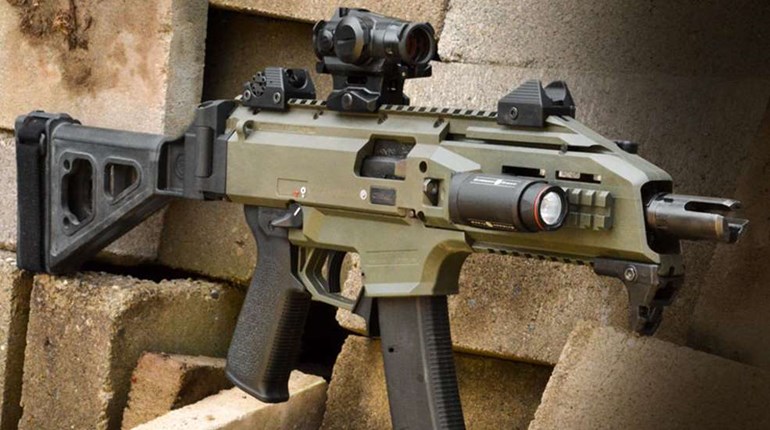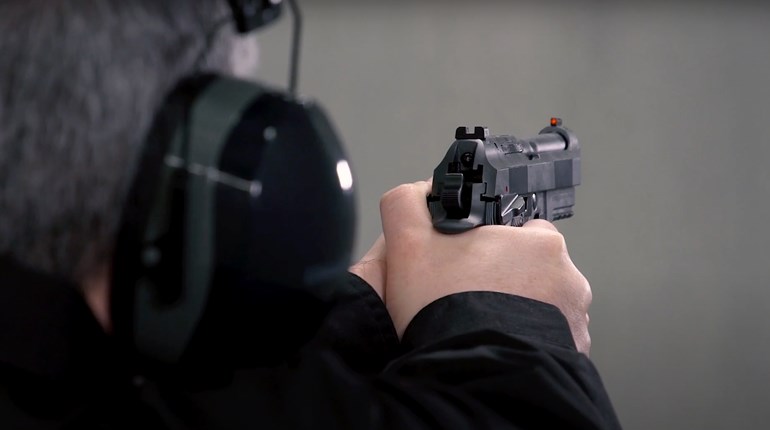
Wouldn't it be great if you had a handy tool to give you real-time feedback about what you're doing wrong (or could improve) on the shooting range? Great news: You already do, and it's called your target! When it comes to spotting shooter error there is no greater tool than your impacts. While many shooters like to blame a missed shot on factors such as the wind, a bad round of ammunition or sights, a skilled shooter knows that 90 percent of the time this is not the case. When you’re training at close distances, even the most erratic ammunition should be able to stay within a 3-inch circle. Wind also has no effect at these distances should you be shooting outside. Lastly, a sight would basically have to be missing altogether in order to influence excessive error, and even then, that wouldn’t explain why your shots are consistently off center. So add that all up and what are you left with?
Well, just you!
Fear not, this is actually the best-case scenario for improvement. While we have no control over the weather, factory ammo or fixed sights, we do have complete control over ourselves. The instructions are even written for us in a language that I like to call “target.” Learning to speak target is easy and there are five phrases that I would like to share with you--even give away a little bit of what we “sell” at Renaissance Firearms Instruction.
1. Flinching
I swear I’m not a pompous jerk, but boy do I love jumping into the “Brand G gun always shoots low and left” conversation when it breaks out in a gun shop or on the range. I once had someone get started on that trope, to which I replied, “Low and left, correct?” He answered, “No, low and right.” After hearing this I exclaimed “Ah, you’re a lefty!” and as you would have guessed, I nailed it. I knew this about the shooter because flinching shows up as shots, or even groups down and to the right for left-handed shooters. Righties will see this same phenomenon on the lower left quadrant of their target.
Flinching is really easy to understand, when you consider that a gun firing is essentially an explosion next to the most delicate part of your body, your face. I always ask my students to show me what they would do if they had a firecracker in their hand and somebody suddenly lit the fuse. If you think about it you wouldn’t wind up and throw it, you would simply flick your wrist and snap it away from you, as this is the quickest form of disposal. What you are experiencing is the simple, instinctive "fight or flight" mechanism protecting yourself from a threat. Your hands make the same exact motion when you fire your pistol. This is a natural human reaction and this means that everyone has this issue to some degree. That goes for every man, woman and child; we all flinch from time to time. This is especially true if you are not yet cognizant of it. (Yes even I flinch. I did it once on T.V. and it cost me 100 grand, it was beautiful.)
Don’t think you do it? Pay attention to the next time a pistol doesn’t go off when you are expecting it to. You should be able to see the pronounced dipping motion very easily without recoil covering it up. So how do you overcome it? Well it’s not easy. It’s essentially training yourself not to blink when your eyes are dry, or not to yawn when you are tired. It starts with first accepting that you do indeed do it and that might even require having someone point it out. While the firearms community loves gadgets and targets to diagnose shooter error, the following advice only works under the guidance of a certified instructor. After catching a plane back home I called up a buddy and said Mr. “TOP SHOT” needs some help and, after an hour of training (and years of practice), I’ve learned to control this most detrimental of shooting habits.
How did I do it?
For starters I figured out how hard I actually needed to grip my pistol. Each pistol will require a different amount of force based on caliber, size and grip texture. Using “X percent of your strength” is a bunch of garbage made up by instructors who don’t care enough about their students to give them a well-thought-out answer. The answer is to apply enough pressure with your shooting hand to where you can hold the gun comfortably. Next with your support hand--let this hand have more pressure than your shooting hand, then fire a series of shots. If your hands stayed put, relax your grip a little and fire some more. Repeat the process until one hand starts to slip. This is your minimum gripping pressure. Learn to grip slightly harder on a consistent basis and you are on your way to curing flinch. Practicing good follow through and learning to ignore when the trigger is going to break will be your next steps to thwarting this involuntary movement.
2. Head bobbing/Eye darting
Here’s another fun fact of human nature: Where your eyes look, your body follows. Here's proof: Place your sights on target, then shift your eyes to the ceiling, and then back to your gun. Most likely your sights are sitting slightly higher on the target now. If you moved your head this will be even more pronounced. Many shooters exhibit this motion as the trigger breaks, which is a split second before the bullet leaves the barrel. If this happens, your target will have high hits on it.
Shooters will do this for one of two reasons. The first is a reaction, just as if someone came around the corner and yelled “BOO!” Our head, neck and shoulders snap back from whatever just jumped out at us. Just as with flinching all that is required is relaxation of the muscles involved. That means your neck, shoulders and even your face shouldn’t be tense or even carry an expression, grimace or cringe.
The other reason this might happen is a shooter is trying to look up to see where they hit as the bullet impacts their target, and that’s an easy solution…Just don’t do it!
3. Breathing
When taking untimed bullseye-style shots, your breathing is just as important in pistol shooting as it is in rifle shooting. If you notice your target has holes that look like shirt buttons, then the problem usually lies in your breathing technique. Just as in rifle shooting you want to shoot in between breaths; we refer to this period as your natural respiratory pause. Simply take a deep breath in, exhale it all the way and after your lungs are empty start pressing the trigger until the gun fires. The key is remembering to do it, and that comes with lots of practice. A good dryfire routine will cure this problem very quickly.
4. Pushing the gun
Until we know better, most of us will press the trigger with the area between the first and second joint on our trigger finger. Unfortunately this part of our finger doesn’t come straight back at all. We should be pressing the trigger with the center of the first pad, right about where the fingerprint swirls. Righties using “too much” trigger finger will show hits on the left side of the target. If they use too little then they will show hits on the right side of the target (usually). You can reverse this information for southpaws.
The fix is as simple as finding the perfect trigger finger placement and committing it to feel. Keep in mind that it will change from gun to gun. It will also change slightly if you change back straps. Shooters shooting DA/SA pistols should be cautious as it is common to use too much trigger finger during the first shot, as the trigger movement is elongated and usually requires much more pressure.
5. Relaxation of grip during firing
If you notice shots that are low on your target without the angular component described above you are likely relaxing your grip while the gun is going off. This is why we don't give the advice of “gripping as hard as you can” when teaching shooters how to first operate their pistol. The solution to this is covered above with how to solve flinching. I decided to end with this error as it is often the road that many travel down as they attempt to solve any of the above issues through “force.”
The preceding is a comprehensive list of the most common forms of shooter error that I have encountered in the past eight years (or 35,000 students) and cover nearly everything that takes folks out of the X-ring. While targets like “the wheel of misfortune” certainly are alluring; they are a bit too cluttered and don’t offer the feedback that another human being can offer. They also can’t watch you fire the shot which is critical, as these errors are often mistaken for one another. Remember that shooting is an Olympic sport, you won’t get good overnight and won’t make any progress at all without knowing what’s wrong or how to practice.
Stay diligent and you will get there!







































